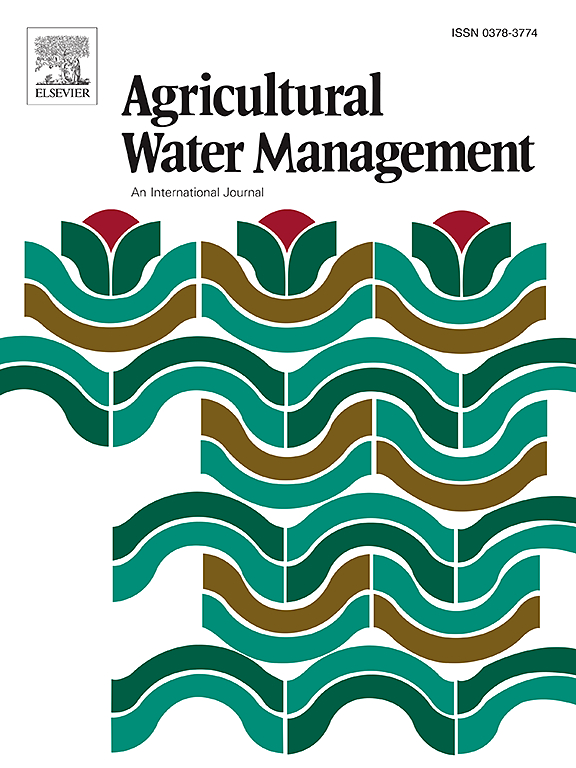秋季灌溉时间和灌溉量对季节性冻土土壤水盐组分迁移的影响
IF 5.9
1区 农林科学
Q1 AGRONOMY
引用次数: 0
摘要
在季节性冻土区和盐渍化区,汛期灌溉时间、灌溉量和冻融期土壤水盐运动动态对洪水灌溉的淋溶效果和土壤水分保持效果有很大影响。虽然现有的研究主要集中在总盐含量上,但对不同灌溉时间和灌溉量下盐的组分特异性迁移行为的探索还不够充分。为了解决这一问题,进行了为期两年的灌溉田间试验,涉及6个洪水灌溉处理,包括2个灌溉时间和3个灌溉量。采用FREZCHEM模型定量测定可溶性和沉淀盐组分。结果表明:灌溉时间对最终土壤水盐含量及其变化有显著影响,而150 ~ 210 mm灌水量对最终土壤水盐含量影响较小;平均而言,后期灌溉处理(LAITs)比早期灌溉处理(EAITs)和不灌溉处理分别提高了0.05 cm³ /cm³ 和0.2 cm³ /cm³ 土壤含水量。这是由于淋滤期间蒸发持续时间和向下的水通量减少,以及冻结期间更强的向上对流驱动的地下水补给增强。尽管不同处理的总体冻融持续时间相似,但区域冻融区土壤冻结的发生时间比区域冻融区早13天。在灌溉时间相同的情况下,较大的灌溉量推迟了冻融期的结束。淋滤期(10 ~ 12月),0 ~ 1 m深度土壤含盐量下降4.9 ~ 56% %。相反,在冻融期间(12月至4月),盐的积累量为9.7 - 26% %,特别是在lait中,而eait的脱盐量约为16 % -37.8 %。浸出期的主要浸出组分为Ca、Cl、HCO₃和Na,其还原量与其初始浓度呈线性相关。冻融期间,由于热势梯度和水势梯度驱动的向上对流以及溶液离子的沉淀,so_4和Na是主要的积累成分。在所有处理中,灌水量为150 mm的LAIT表现出最有效的效果,与其他处理相比,土壤含水量的增加更明显,脱盐率更高。本文章由计算机程序翻译,如有差异,请以英文原文为准。
Effects of autumn irrigation timing and amounts on soil water and salt component migration in seasonally frozen soils
In seasonally frozen and salinized regions, the effectiveness of flood irrigation in leaching salts and conserving soil moisture is strongly influenced by irrigation timing, amount and the dynamics of soil water and salt movement during the freeze-thaw period. While existing studies predominantly focus on total salt content, the component-specific migration behavior of salts under varying irrigation timing and amount remains insufficiently explored. To address this issue, a two-year irrigation field experiment was conducted, involving six flood irrigation treatments that combined two irrigation timings and three irrigation amounts. The FREZCHEM model was employed to quantify both soluble and precipitated salt components. Results showed that final soil water and salt contents, as well as their variations, were significantly affected by irrigation timing, while were only slightly influenced by irrigation amounts ranging from 150 to 210 mm. On average, late irrigation treatments (LAITs) increased soil water content by 0.05 cm³ /cm³ and 0.2 cm³ /cm³ more than early irrigation treatments (EAITs) and the no-irrigated treatment, respectively. This was attributed to a reduction in evaporation duration and downward water flux during the leaching period, along with enhanced groundwater recharge driven by stronger upward convection during the freeze period. The onset of soil freezing in LAITs occurred 13 days earlier than in EAITs, although the overall freeze-thaw duration remained similar across treatments. Under the same irrigation timing, larger irrigation amounts delayed the end of the freeze-thaw period. During the leaching period (October to December), soil salt content within the 0–1 m depth decreased by 4.9–56 %. Conversely, during the freeze-thaw period (December to April), salt accumulated by 9.7–26 %, particularly in LAITs, while EAITs exhibited an approximate 16 %–37.8 % improvement in desalination. The main leached components during the leaching period were Ca, Cl, HCO₃, and Na, with reductions linearly correlated with their initial concentrations. In contrast, SO₄ and Na were the predominant accumulating components during the freeze-thaw period due to upward convection driven by thermal and water potential gradients, as well as the precipitation of solution ions. Among all treatments, the LAIT with an irrigation amount of 150 mm demonstrated the most effective performance, exhibiting superior increases in soil water content and higher desalination rates compared to other treatments.
求助全文
通过发布文献求助,成功后即可免费获取论文全文。
去求助
来源期刊

Agricultural Water Management
农林科学-农艺学
CiteScore
12.10
自引率
14.90%
发文量
648
审稿时长
4.9 months
期刊介绍:
Agricultural Water Management publishes papers of international significance relating to the science, economics, and policy of agricultural water management. In all cases, manuscripts must address implications and provide insight regarding agricultural water management.
 求助内容:
求助内容: 应助结果提醒方式:
应助结果提醒方式:


